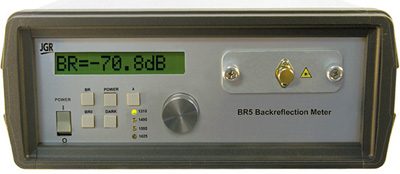
|
|
The JGR BR5 Backreflection Meter series is a user-friendly instrument developed with extremely stable optics for precise measurement of backreflection, insertion loss and power. The BR5 features up to four built-in laser sources at wavelengths of 850, 1310, 1490, 1550, 1625 or 1650 nm (depending on fiber type). An intuitive display and keypad, with one-button access to BR and IL modes, simplifies the collection and management of measurement data. The meter may be controlled through remote interface (GPIB, RS232, or USB*) or locally via the user-friendly front panel keypad and display. It is available in single-mode and multimode, the BR5 is ideal for measurements of connectors, components, and systems. Specifications. Fiber Type: 9/125(SM), 50/125 or 62.5/125 (MM). Operating Wavelengths: 1310 / 1490 / 1550 / 1625 / 1650 nm (SM), 850 / 1310 nm (MM). Backreflection Range: 0 to -80 dB (SM), 0 to -60 dB (MM). Backreflection Accuracy: ± 0.4. Detector Type: 2mm InGaAs / 5mm Ge. Power Range: 0 to -80 dBm, 0 to -60 dBm. Absolute Power Accuracy: ± 0.25 dB. Relative Power Accuracy: ± 0.05 dB (< 5 dB loss), ± 0.15 dB (> 5 dB loss). Remote Interface: GPIB, RS232, USB. Display: 16 character LCD.
Additional Repair Services / Information.
JGR BR5 Configurations
Common configurations.
Single Mode Configurations, 9/125 µm fiber:
BR5-3456-2-09FA: one 1310 nm laser, one 1490 nm laser, one 1550 nm laser, one 1625 nm laser, 2 mm InGaAs detector
BR5-3457-2-09FA: one 1310 nm laser, one 1490 nm laser, one 1550 nm laser, one 1650 nm laser, 2 mm InGaAs detector
BR5-3050-5-09FA: one 1310 nm laser, one 1550 nm laser, 5 mm Ge detector
BR5-3450-5-09FA: one 1310 nm laser, one 1490 nm laser, one 1550 nm laser, 5 mm Ge detector
BR5-3456-2-09FA: one 1310 nm laser, one 1490 nm laser, one 1550 nm laser, one 1625 nm laser, 5 mm Ge detector
Multimode Configurations,
BR5-8300-5-50FA: one 850 and one 1310 nm laser 5 mm Ge detector, 50/125 um fiber
BR5-8300-5-62FA: one 850 and one 1310 nm laser 5 mm Ge detector, 62.5/125 um fiber
|